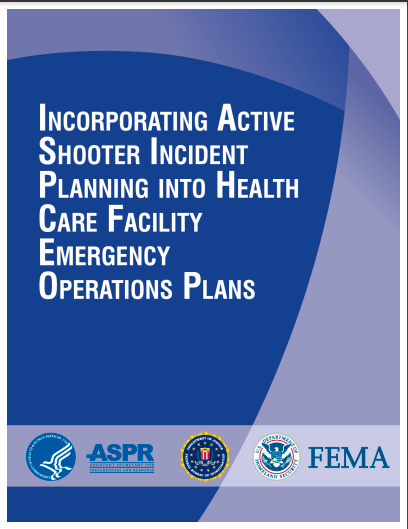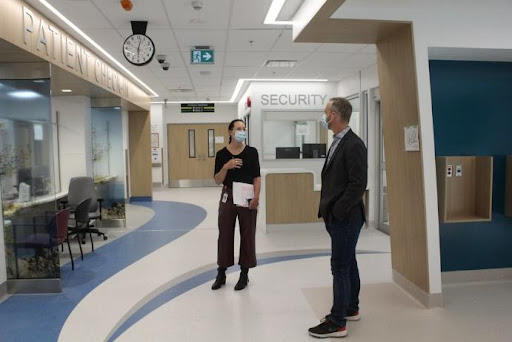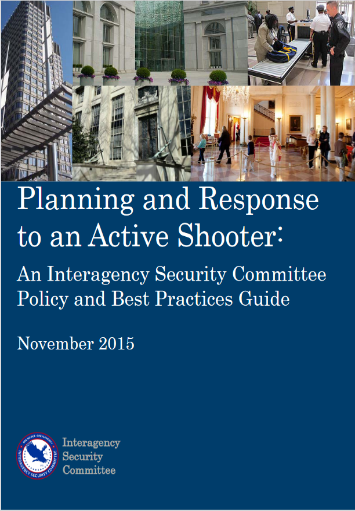Public Resources
Public Resources
Planning for an Active Shooter Situation
[edit]
[edit]
Jump to: Hospital Considerations: Preparing for Active Shooter Incidents | Resources to Strengthen Your Emergency Plans
All business and organizations should engage in planning for emergency situations, including active shooters.

According to recommendations from ASPR and others, your Emergency Operations Plan (EOP) should include:
- Proactive steps, including training, that can be taken by employees to identify individuals who may be on a trajectory to commit a violent act
- A preferred method for reporting an active shooter
- An evacuation policy and procedure
- Emergency escape procedures and route assignments (e.g., floor plans, safe areas)
- Lockdown procedures for individual units, offices, and buildings ⁵
Hospital Considerations: Preparing for Active Shooter Incidents
As stated in the "Active Shooter Response" report, available through the National Library of Medicine, responding to an active shooter requires a multi-faceted approach. Unfortunately, there is no single tactic that is consistently successful, so the threat must be continually assessed.

- Establish a framework on how to deal with an active shooter in the hospital
- Involve everyone in the facility
- Consider multiple scenarios and practice routines
- Invite law enforcement to help develop a robust program and understand the risks
- Develop a method of recognizing the problem and have a reporting system in place
- Establish and enforce security measures including:
- Ensure the wearing of a name badge with photo for all employees
- Maintain that all badge or card access readers have the ability to be reprogrammed to block a former employee from entering the hospital
- Make certain that employees are able to report suspicious activity or an individual without fear of reprisal⁶
Design Considerations for a Safe Emergency Department
 While emergency departments face a myriad of safety concerns, specific actions can be taken to ensure the welfare of patients, visitors, staff, and physicians against active assailants. "Design Considerations for a Safer Emergency Department," from the American College of Emergency Physicians (ACEP) offers several proactive measures:
While emergency departments face a myriad of safety concerns, specific actions can be taken to ensure the welfare of patients, visitors, staff, and physicians against active assailants. "Design Considerations for a Safer Emergency Department," from the American College of Emergency Physicians (ACEP) offers several proactive measures:
- Establish a visible and active security presence
- Create a department layout allowing for clear lines of sight, avoiding "islands," which expose staff to danger
- Use a metal-detecting wand to scan patients and visitors of the emergency room
- Ensure triage rooms have multiple exits to allow for escape
- Consider installation of bullet-resistant glass where appropriate
- Install panic buttons in easily accessible areas
- Add an electronic locking system or "lockdown" capability to the entire emergency department if one is not in place⁷
Resources to Strengthen Your Emergency Plans
Workplace Violence:
These resources will help with any workplace violence scenario, including active assailant:
- Security Readiness Assessment Tool from the New Jersey Hospital Association, with sections for Acute Care, Long Term Care, and Health Centers
- Workplace Violence Toolkit from the American Society for Healthcare Risk Management
- Micro-module reviewing the key principles of Behavioral Intervention Teams (BITs) from NCBRT (free account required). BITs are formed to respond to the early detection of and intervention of worrisome or potentially harmful behavior and to prevent campus violence.
Active Assailant:
The following resources are helpful for strengthening emergency plans for active assailant situations:
- For healthcare settings:
- Incorporating Active Shooter Incident Planning into Health Care Facility Emergency Operations Plans from FEMA and ASPR
- Action Guide for Hospitals & Healthcare Facilities from CISA, including potential indicators, actions for staff, and mitigation strategies
- Active shooter planning and response in a healthcare setting from the FBI, providing comprehensive guidance on planning for active shooter events; compiled by the Healthcare and Public Health (HPH) Sector Coordinating Council (SCC)
- The On-Campus Hospital Armed Assailant Planning Considerations document from ASPR TRACIE helps hospital planners prepare their facilities in the event of an armed assailant or active shooter situation on campus
- For all settings:

- Resources for Active Shooter Emergency Action Plans (EAPs) from CISA, including a planning guide, video reviewing fundamental planning concepts, and an EAP plan template
- Planning and Response to an Active Shooter: Policy and Best Practices Guide from the Interagency Security Committee
- Micro-module on Building Emergency Action Plans (BEAPs) from NCBRT (free account required). A BEAP details emergency actions at the building level, including occupant actions and should support an Emergency Operations Plan
- Guides for developing emergency plans from the FBI, each with "a closer look" at active shooter situations:
After-Action Reports:
After-Action Reports (AARs) are used to analyze and understand strengths and areas for improvement after an incident response. Consulting both national and international AARs can provide important information when creating or improving upon one's own emergency plan. Here are some example AARs:
- US Department of Justice Critical Incident Review from Pulse Night Club attack in Orlando, FL on June 12, 2016
- FEMA's After Action Report from Las Vegas shooting on October 1, 2017
- Local Public Safety Commission's report from the Marjory Stoneman Douglas High School attack in Parkland, FL on February 14, 2018
- The City of Virginia Beach's Independent Review of the Virginia Beach Mass Shooting on May 31, 2019
« Previous | Topic Home | Next »
Reference(s):
⁵Active shooter planning - phe.gov HHS Office of the Assistant Secretary for Preparedness and Response (ASPR). (2014). Retrieved July 5, 2022, from https://www.phe.gov/Preparedness/planning/Documents/active-shooter-planning-eop2014.pdf
⁶Schwerin, D. L., Thurman, J., & Goldstein, S. (2022, January). Active shooter response. National Library of Medicine. Retrieved June 30, 2022, from https://www.ncbi.nlm.nih.gov/books/NBK519067
⁷Huddy, J. (2017). Design considerations for a safer emergency department. American College of Emergency Physicians. Retrieved July 5, 2022, from https://www.acep.org/globalassets/sites/acep/media/safety-in-the-ed/designconsiderationsforsaferemergencydepartment.pdf

